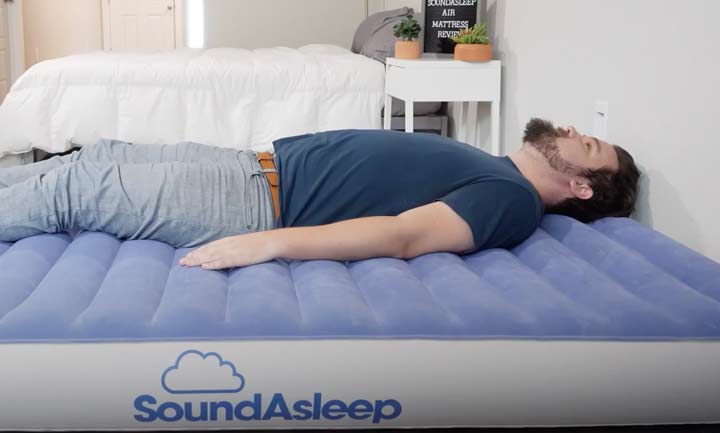Whether you’re preparing for the occasional guest to stay the night or moving into a new home before your new mattress arrives, an air mattress is a good thing to keep in your linen closet. But sleeping on an air mattress is certainly no hotel stay. Air mattresses can take a toll on your body, cause backaches, and negatively affect your sleep quality, especially if you’re sleeping on one for more than one night.
Luckily, we have a few suggestions for making an air mattress more comfortable, whether you’re sleeping on one for an extended period of time or for just one night. Keep reading for tips on how to sleep comfortably on an inflatable bed!
Pros and Cons of Sleeping on an Air Mattress
If you’re choosing between an air mattress and a hard floor, there are plenty of pros to sleeping on an air mattress. But if you’re looking for a long-term solution, an air mattress might not be your best option. Take a look at the lists below for an overview of the pros and cons of sleeping on an air mattress.
Pros
- A comfortable air mattress is a great space-saving option for overnight guests. Especially if you don’t have a guest room, setting up an air mattress for a few nights is often the best solution when you have visitors.
- An inflatable mattress is also portable. If you like to camp, or are visiting friends without a spare bed, you may get a better night’s sleep on an air mattress than you would sleeping on the floor or a couch.
- Air mattresses are more affordable than traditional mattresses. If you’re saving up for a traditional bed or in the middle of moving to a new home, an air mattress is a great stop gap solution.
- Think an air bed might work for your needs? Check out our best air mattresses 2025 roundup to explore some options.
Cons
- Sleeping on an air mattress long-term can lead to back pain. This is especially true if your air mattress deflates overnight.
- Most people are not as comfortable sleeping on an air mattress as they are on a normal bed. If you’re looking for the ideal sleeping experience, an air mattress is not the way to go.
- Air mattresses are often made of plastic-based materials, so it is easy to overheat on these beds. Choosing an air mattress that features a cloth sleeping surface (like the Intex air mattress) can help with this issue.
- If your air mattress does not come with a built-in pump, it can be a hassle to re-inflate it before bedtime.

How to Make an Air Mattress More Comfortable
So, how can you make your air mattress more comfortable? Take a look at the hacks below to find out!
Make Sure It’s Properly Inflated
The key to a comfy air mattress is making sure your bed is inflated properly. Your bed should feel comfortable to you when you get on. If you inflate it too much it will feel stiff and hard, and you’ll wake up with sore shoulders and hips (especially if you’re a side sleeper). But if it’s not inflated enough, you won’t get proper support and will feel smothered as your bed “tacos” around you. Plus, you’ll wake up with a sore back and neck in the morning. Make sure to test a few different inflation levels before getting in bed for the night.
Pro tip: if you’ve ever shared a queen size air mattress with a partner, you know the heavier person feels like they’re sinking into the bed while the lighter person finds the bed too firm and stiff (or gets rolled into their partner). To avoid this issue, inflate your air mattress as much as possible to keep the larger partner from sinking too far into the bed. Alternatively, you may want to consider getting two twin size air beds if you know you’ll have multiple guests over often.
Check for Air Punctures
Nothing is worse than waking up in the middle of the night on a deflated air mattress. To avoid this problem, carefully check your air mattress for holes.
How to Find a Hole in an Air Mattress
There are a few different ways to find a hole in your air mattress. First off, remove any bed sheets from the mattress. Next, inflate your bed as much as you can without popping it. Next, check the valve to see if air is hissing out. Valves are the most common leaky areas on an air bed, so checking there first might save you a lot of time.
If you don’t find a leak in the valve, there are a few things you can try. We recommend starting with a visual inspection, which should help you find any large holes. Comb over the mattress and push into it with your hands. Any air escaping will hiss, and you can follow the noise to the source of the hole. Start your inspection at the seams, which are the next most likely places to find a leak.
If that doesn’t work, fill a spray bottle with water and dish soap and slowly spray your inflated air mattress, starting with the seams. The soap will start to bubble around any holes. Some people use a garden hose to spray their mattress for this test. This method will also create air bubbles around a leak. You can also try completely submerging your air mattress in the tub to find air bubbles, but this method is more difficult than the others.
How to Fix a Hole in an Air Mattress
Once you’ve found the hole, you’ll need to patch it up. First, you’ll want to wipe down the spot where the hole is to ensure it’s clean before patching it. Next, we deflate your mattress. After that, we recommend applying some good old fashioned duct tape over the hole. Be sure to cover enough surface area to keep any air from leaking out. Place a flat, heavy object (like a testbook) over the newly applied duct tape and leave it there overnight to give the tape time to set. After that, inflate your bed and press down the areas near the patch to ensure no air is leaking out.
If you prefer not to use duct tape, you can buy an air mattress patch kit online. These kits contain adhesive plastic you can cut to match the hole in your bed. You’ll apply them the same way you would duct tape.
If you patch your hole and your bed is still deflating, you probably have more than one leak. Unfortunately, you’ll have to search for the second hole and patch that one too.
Move the Mattress Onto a Softer Surface
Another way to make your air mattress more comfortable at night is to place it on a soft surface. Instead of putting the bed on hard surfaces like tile or wood floors, move it onto a carpet or mat. This will keep your bed from sliding around or squeaking when you move around at night. This tip is especially useful for combination sleepers or sleepers sharing an air mattress with a partner.
Add a Box Spring or Cot
If a rug isn’t cutting it, you can try placing your air mattress on top of a box spring or cot. If you find the low profile of your air mattress makes getting in and out of bed difficult, lifting your bed on a cot or box spring could make you more comfortable. If you plan to host older guests or parents on an air mattress, adding a box spring could help them sleep a little better.
Upgrade Your Bedding and Pillows
If you’re using a sleeping bag instead of real bed sheets and pillows on your air mattress, it’s time to upgrade. Adding a fitted sheet, comforter, and proper pillow will help you feel more like you’re sleeping in a regular bed. A good pillow can also help support your neck, which might reduce air-mattress-induced neck and shoulder pain.
Pro tip: Place the head of your air mattress against the wall before going to sleep. This will make it feel like you have a headboard, and might make you feel more comfortable at night.
Wondering how to make your air mattress look like a hotel bed? Check out our How to Make the Bed guide for some tips.
Use a Mattress Topper
Finally, adding a mattress topper can make your air mattress much more comfortable. If you’re looking to keep costs down, a basic egg crate topper will add enough extra cushion to make your bed more pressure-relieving. If you prefer something thinner than a mattress topper, a slimmer mattress pad could also make your bed feel a little comfier.
On the other hand, if you’re looking for something more than a basic foam pad (or want to feel like you’re sleeping on a memory foam mattress rather than an air bed), check out the 10 best mattress toppers of 2025.
FAQs
Why is my mattress deflating all of a sudden?
Your air mattress most likely has a hole if it is deflating all of a sudden. Check the valve of your air bed first to see if it’s leaking. If not, refer to the how to find a hole in an air mattress section of this article.
How much weight can an air mattress hold?
It depends on the air mattress, but typically a twin can hold up to 300 lb, a full about 400 lb, and a king 500 lb. Be sure to check the set-up instructions, which should have details about how much weight your specific air mattress can hold.
Why do air mattresses deflate overnight?
Even air mattresses without tears might deflate a little overnight. Temperature changes can make air condense or expand, so when it gets cooler at night your air mattress may deflate a little. Older air beds may also deflate a little at night as air escapes through worn out seams or valves. A high-quality air mattress should not deflate much (if at all) overnight.
Are air mattresses good for your back?
No, using an air mattress long-term can lead to back pain or stiffness. But a high-quality air mattress should support you fairly well for a few nights.
Are air mattresses good for camping?
Lightweight air mattresses are great options for camping. Especially if you are driving to a campsite. If you’re hiking to a campsite, we don’t recommend carrying an air mattress with you, as they can add a lot of weight to your pack.
How long does an air mattress last if used everyday?
A high-quality air mattress should last for a few years. But air beds are not meant for continuous use. If you use your air mattress every day it probably will not last more than three to four months. Many air mattresses do come with a 90-day to one-year warranty.

